| THE
ROOFS OF ENGLAND - STONE SLATES |
| It
is essential to act now if we are to secure the unique history and architectural
character of England's roofs. |
|
Wherever rock
could be split to provide thin enough slabs it was used for roofing
|
| The extraordinary richness
of England’s built heritage is a reminder of our ingenuity in response
to our surroundings and their particular environmental and eographical
characteristics. The roofs and walls of historic buildings are clues to
the geology of the surrounding landscape, and demonstrate the skill by
which the local population used available resources to provide shelter
thereby developing the vernacular or traditional local buildings we now
cherish. Local character and distinctiveness is under threat and limestone
and sandstone roofing is becoming increasingly rare. If the erosion of
regional identity is to be arrested, measures need to be taken to ensure
local materials are made available. |
| Stone slate roofs are a
fundamental part of the distinctive local character of vernacular buildings
in many parts of the country. Their solid beauty achieves a visual
harmony with the stone buildings and the drystone walls of the fields which
makes areas such as the Cotswolds and the Pennines unique. |
| Stone slates are known in
different parts of the country as grey slates, flags, flagstones, thackstones,
slats, flatstones, stone tiles and tilestones. Geologists prefer the term
tilestone as these sandstone and limestone products are not geologically
slates. That is, they are sedimentary rather than metamorphic and
consequently split along a bedding rather than a cleavage plane. Stone
slate however, is historically the most widely and understood term. |
| Top |
GEOLOGY
The properties of the
rock are expressed in the details of the roof
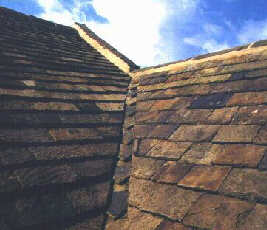
Large slates need mitred
valleys in this case a chevron type |
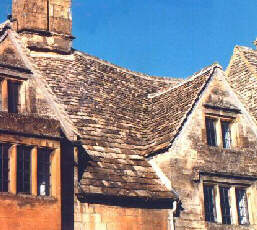
Small slates are used in
swept valleys |
|
| The slaters’ skill and style
of working the raw material contributes to the local and regional distinctiveness
of stone roofs, but the character of the roof is derived principally from
the colour and texture of the stone slates, their size, thickness and roughness.
The nature of the rock dictates the manner in which it can be worked, the
treatment of the hips, valleys, ridges, dormers, eaves and abutments of
the roof. The aim is to resist the weather, but the craftsperson's artistry
and understanding of the materials determines the expression. |
| The differences in colour
and texture in the sedimentary rock from which the slates are made arise
from the conditions in which the beds were deposited millions of years
ago. Shallow water produced a rippled stone. Deeper, calmer waters produced
flatter smoother and generally larger slates. In slow moving water the
sand particles are smaller and the slates’ texture is finer, and less grainy.
The variety of colours from pale yellow to red, which is a result of iron
staining, together with the variety in texture, imparts the local distinctiveness,
which can vary from village to village. Until improvements in transport
made it easy to import cheaper, mass produced products, each village used
its local stones, providing its buildings with a distinctive local fingerprint. |
| Stone slates have always
been laid in courses diminishing in size from the eaves (where the slates
can be up to four feet long) to the smaller stones at the ridge (which
may be as small as four inches long). This careful sizing of the slates
reflects the character of the rock and the selection of sizes which could
be made. It reduced wastage by ensuring even the smallest stones could
be used. |
| Top |
| QUARRYING OR DELVING |
| Stone slate quarrying is
a small scale operation, which generally exploited the relatively thin,
near surface deposits. Quarrying occurred either; along the crest of a
steep slope where the rock was parallel with the surface and could be reached
with a minimum of digging or using an open pit method. The latter is the
usual method in southern England. In rare cases, such as the Collyweston
in Northamptonshire, the stone was only found at a depth which meant that
it had to be mined. Here the unriven blocks of stone were stored underground
until the promise of cold weather; the stone would then be brought out
into the open so that the frost could split it into slates. |
| Extraction for stone slates
remains low tech, which reflects the nature of slate and the need to produce
slabs which are as large as possible. Historically all the extraction processes
were by hand; horse or man-powered mechanisation was only adopted in the
largest workings in the form of narrow gauge rail systems. |
| Rock unsuitable for roofing
was made into flooring, flagging, kerbs and walling stones, a range of
products which resulted in the visual harmony between the architecture
and the landscape. Conversion of the rock to roofing slates was traditionally;
entirely done by hand and remains so for most of the steps involved. The
stone is split to the desired thickness with a chisel or by ‘frosting’.
The edges are then trimmed square and bevelled with a hammer. |
| Top |
| CONSERVATION ISSUES |
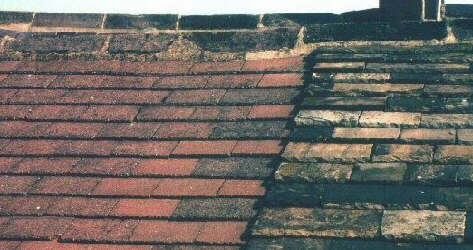
If any regard is to be had
to the general beauty of the landscape, the natural material of the special
countryside should be used instead of imported material. William Morris
1890
|
|
| Stone slates have been used
since Roman times. Originally used as a prestigious alternative to thatch,
stone slates eventually, became a standard roofing material. They make
a unique contribution to the appearance of out towns and villages. Yet
the qualities of colour and texture that they bring to the rural scene
are vanishing before our eyes as old roofs are re-clad with inappropriate
substitutes. The cycle of substitution by cheaper alternatives leading
to declining production and increasing costs, has been a problem since
the nineteenth century. Improvements in transport facilitated the importation
of cheaper, alien products from the furthest corners of the country and
beyond. The consequence has been that in many regions the production of
stone slates ceased years ago, with the few remaining producers in a precarious
position and largely dependent on indirect grant support through heritage
bodies for their continued existence. The use of mass-produced products
brings with it standardised roof details, so that buildings eventually
look the same wherever you go. |
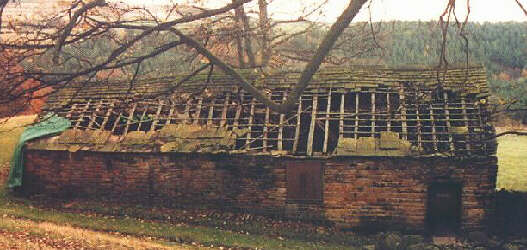
This roof has been stolen
and sold to other buildngs three times
|
|
| The options of using salvaged
slates creates a market which encourages the removal of stone slates from
their original location, and in the extreme may encourage theft. When local
products disappear so do the slating traditions and with them the regional
roofing character. |
| Top |
| DISAPPEARING SKILLS |
| Stone slates demand special
skills in production and use, today there are few craftspeople able to
offer such expertise. In times of rising unemployment in rural areas, we
should take the opportunity to reinvest in these traditional local skills
and at the same time ensure the preservation of our stone slate roofing
tradition, a vital part of our heritage. The stone thackers as they were
once known, blended the sizes and textures of the slates to create a defence
against the worst of Britain’s weather. That skill at working with the
stone is now disappearing as the material grows scarcer. |
| At present stone slating
is not included in any of the NVQ courses available in this country; even
in areas where the towns are dominated by stone slate roofs. There is a
need for training to ensure that the best historical techniques are adapted
to meet modern needs (such as insulation at ventilation) without compromising
the roof’s traditional appearance. Likewise, there are few opportunities
for architects, surveyors and others to learn the necessary skills to rebuild
or repair a traditional stone slate roof so that it will last another two
to three hundred years. |
| Training is needed in all
areas of the stone slate industry. English Heritage is developing a training
module, and a guidance leaflet for conservation practitioners. Roofing
companies also have a role to play in the training of craftspeople. Educational
establishments also need to be equipped to meet the challenge of the necessary
training. |
| Top |
| PRACTICAL ISSUES: DETAILING
AND SPECIFICATION |
| The objective is to conserve
the distinctive regional appearance of roofs. This means choosing the correct
materials and techniques to ensure that the roof will do its job. The detailing
of the roof, its pitch and the treatment of the eaves, valleys, ridges
and dormers - evolved in response to materials and climate, and may also
vary according to the building type and its period. Correct detailing not
only creates the character of the roof but also ensures that the roof performs
satisfactorily. In the Cotswolds for example swept valleys are common as
the small tapering slates fit comfortably into a curve. Conserving these
vernacular traditions will ensure that neither the character nor the efficiency
of the roof is lost. |
| Stone slate quarries were
always small and supplied small local communities. The appearance of stone
slates varies widely even within one geological bed. Rough or smooth, thick
or thin, large or small, light or dark in colour: these factors give variety
and expression to the roof. The preferred policy is therefore to encourage
many small sources of supply rather than one large source. This has the
advantage of reducing the impact on the environment. Where there is only
a very small demand for a particular type of stone, the quarry can be operated
intermittently, perhaps only for a few months over a period of several
years. |
| The use of material salvaged
from other old buildings should be avoided and new stone slates used wherever
possible. Second hand slates should only be re-used on the building from
which they were recovered. Tiles made from substitute materials such as
fibre resin, artificial stone, or concrete should not be used on historic
buildings. |
| The failure of a stone slate
roof is usually caused by the failure of the nails or pegs used to fix
the slates to the battens, the decay of battens or rafters, or lamination
or cracking of the slates’ top edges. When reroofing, it is advisable to
record the roof prior to stripping, to ensure that the existing details,
such as the number of courses, are properly reinstated. Stripping should
be carried out carefully to ensure that all sound stone slates remain undamaged
so that they can be sorted according to type, size and thickness ready
for re-use. |
| Top |
| SAVING OUR STONE SLATE ROOFS:
THE SOUTH PENNINE EXPERIENCE |
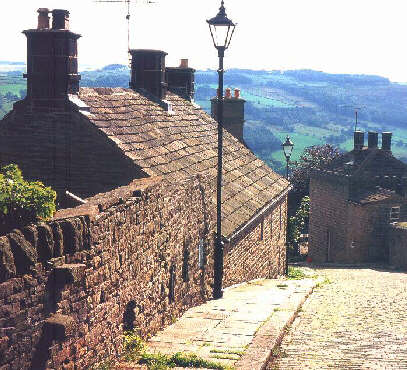
Roof, walls, flags and curbs;
the harmony of the vernacular tradition.
|
|
| The decline of the stone
slate industry in the South Pennines means that the fundamental visual
character of the whole region is under threat. The unique Pennine landscape
provided by the dry stone walls and stone cottages of the villages and
towns, with their sturdy stone roofs, achieves a visual harmony with the
rocky crags of the hills. This special character is gradually being eroded
by the use of unsatisfactory substitute roofing material, or different
stone from other regions. |
| To revive the industry English
Heritage and its partners have taken the South Pennines as a model and
carried out a two year research project into the resumption of stone slate
roofing production in Derbyshire and the Peak District. The results are
now providing a model for this national campaign. The research attempts
to tackle the problem by: identifying the size of the market, examining
the impact of current heritage and planning policies and the allocation
of historic building grant aid, and determining where training and education
is needed. The results provide information to manufacturers, specifiers
and users and locates possible sites for small scale, minimal impact extraction
of suitable stone. |
| By reviving the stone slate
industry English Heritage and its partners aim to fulfil conservation goals
at the same time as stimulating employment and the local economy. Stone
slate extraction is a low energy industry producing a long lasting quality
product, thus satisfying today's requirements for the use of environmentally
friendly materials and sustainable development. |
| Top |
| STONE SLATE: A SUSTAINABLE
PRODUCT FOR A NEW MILLENIUM |
| - stone slates are the epitome
of a sustainable material. They last hundreds of years and are capable
of almost continuous re-use |
| . |
| - the production of stone
slates is energy efficient and because the industry is local, transport
costs are low |
| . |
| - stone slate roofs are
thermally efficient, keeping household bills down |
| . |
| - durability makes stone
slates one of the cheapest roof coverings over the long term; they will
out perform mass-produced substitutes |
| . |
| - the revival of the stone
slate industry will promote economic growth and employment opportunities |
| . |
| - demand can generally be
supplied by re-opening old quarries which are small scale operations with
low visual or environmental impact |
| . |
| - the production of new
stone slates would help to defend existing stone slate roofs from the threat
of dismantling and theft to satisfy local demand |
| . |
| - traditional skills currently
on the verge of extinction, can be saved. Only the combination of hand
and eye can maximise the output of slates from unpromising rock which gives
stone slates their distinctive character stone slate quarries can also
meet local demand for walling, kerbs, flag stones and other paving. |
|
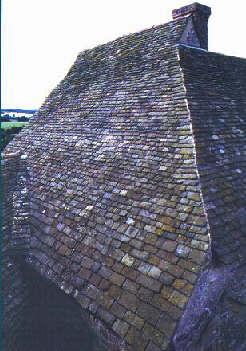
Stokesay Castle, Shropshire
|
|